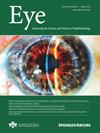中度老年性黄斑变性患者眼部高传输缺陷大小与病情发展之间的关系
IF 2.8
3区 医学
Q1 OPHTHALMOLOGY
引用次数: 0
摘要
方法回顾性研究了连续的 iAMD 患者的光学相干断层扫描(OCT)数据。所有基线时存在或不存在 iRORA(但不存在 cRORA)的 iAMD 眼睛都被纳入其中。分级人员评估了基线时是否存在hyperTD(小:63-124微米;中:125-249微米;大:脉络膜面OCT直径≥250微米)以及两年后的进展情况。结果 在145只两年后未发展为新生血管性AMD的眼球中,发展为或发展为iRORA或cRORA的眼球包括基线时无、小、中、大超视网膜直径组,分别为13只眼球(10.7%)、5只眼球(83.3%)、9只眼球(81.8%)和6只眼球(85.7%)(P值为0.001)。与无 hyperTDs 相比,小、中、大 hyperTDs 组的进展几率比(95% CI)分别为 41.6(4.5-383.6)、37.4(7.3-192.0)和 49.9(5.6-447.1)(P 值≤0.001)。结论虽然大多数没有超远端视网膜病变的 iAMD 眼睛在两年内的 OCT 显示保持稳定,但有任何大小超远端视网膜病变的眼睛似乎有更高的视网膜病变风险。高TD可能是识别高风险iAMD患者的重要OCT生物标志物。本文章由计算机程序翻译,如有差异,请以英文原文为准。


Relationship between hypertransmission defect size and progression in eyes with intermediate age-related macular degeneration
To determine the associations between the presence of various-sized hypertransmission defects (hyperTDs) and progression to incomplete retinal pigment epithelial (RPE) and outer retinal atrophy (iRORA) and complete RORA (cRORA) in eyes with intermediate age-related macular degeneration (iAMD). Optical coherence tomography (OCT) data from consecutive iAMD patients, were retrospectively reviewed. All of iAMD eyes with or without iRORA (but not cRORA) at baseline were included. Graders evaluated the presence of hyperTDs at baseline (small: 63–124 µm; medium: 125–249 µm; large: ≥ 250 µm in diameter on choroidal en face OCT) and the progression two years later. Of the 145 eyes that not developed neovascular AMD at two years, the eyes that progressed to or developed iRORA or cRORA included 13 eyes (10.7%), 5 eyes (83.3%), 9 eyes (81.8%), and 6 eyes (85.7%) in the groups with no, small, medium, and large hyperTDs at baseline, respectively (P-value < 0.001). The odds ratios (95% CI) for progression were 41.6 (4.5–383.6), 37.4 (7.3–192.0), and 49.9 (5.6–447.1) in the small, medium, and large hyperTDs groups, compared to no hyperTDs (P-value ≤ 0.001). Eyes with ≥ 2 hyperTDs also showed more frequent progression than eyes with one or no hyperTDs (100% vs. 16.4%; P-value < 0.001). While most iAMD eyes with no hyperTDs remained stable on OCT over two years, eyes with hyperTDs of any size appeared to be at a higher risk for progression. HyperTDs may provide an important OCT biomarker for identifying high-risk iAMD patients.
求助全文
通过发布文献求助,成功后即可免费获取论文全文。
去求助
来源期刊

Eye
医学-眼科学
CiteScore
6.40
自引率
5.10%
发文量
481
审稿时长
3-6 weeks
期刊介绍:
Eye seeks to provide the international practising ophthalmologist with high quality articles, of academic rigour, on the latest global clinical and laboratory based research. Its core aim is to advance the science and practice of ophthalmology with the latest clinical- and scientific-based research. Whilst principally aimed at the practising clinician, the journal contains material of interest to a wider readership including optometrists, orthoptists, other health care professionals and research workers in all aspects of the field of visual science worldwide. Eye is the official journal of The Royal College of Ophthalmologists.
Eye encourages the submission of original articles covering all aspects of ophthalmology including: external eye disease; oculo-plastic surgery; orbital and lacrimal disease; ocular surface and corneal disorders; paediatric ophthalmology and strabismus; glaucoma; medical and surgical retina; neuro-ophthalmology; cataract and refractive surgery; ocular oncology; ophthalmic pathology; ophthalmic genetics.
 求助内容:
求助内容: 应助结果提醒方式:
应助结果提醒方式:


